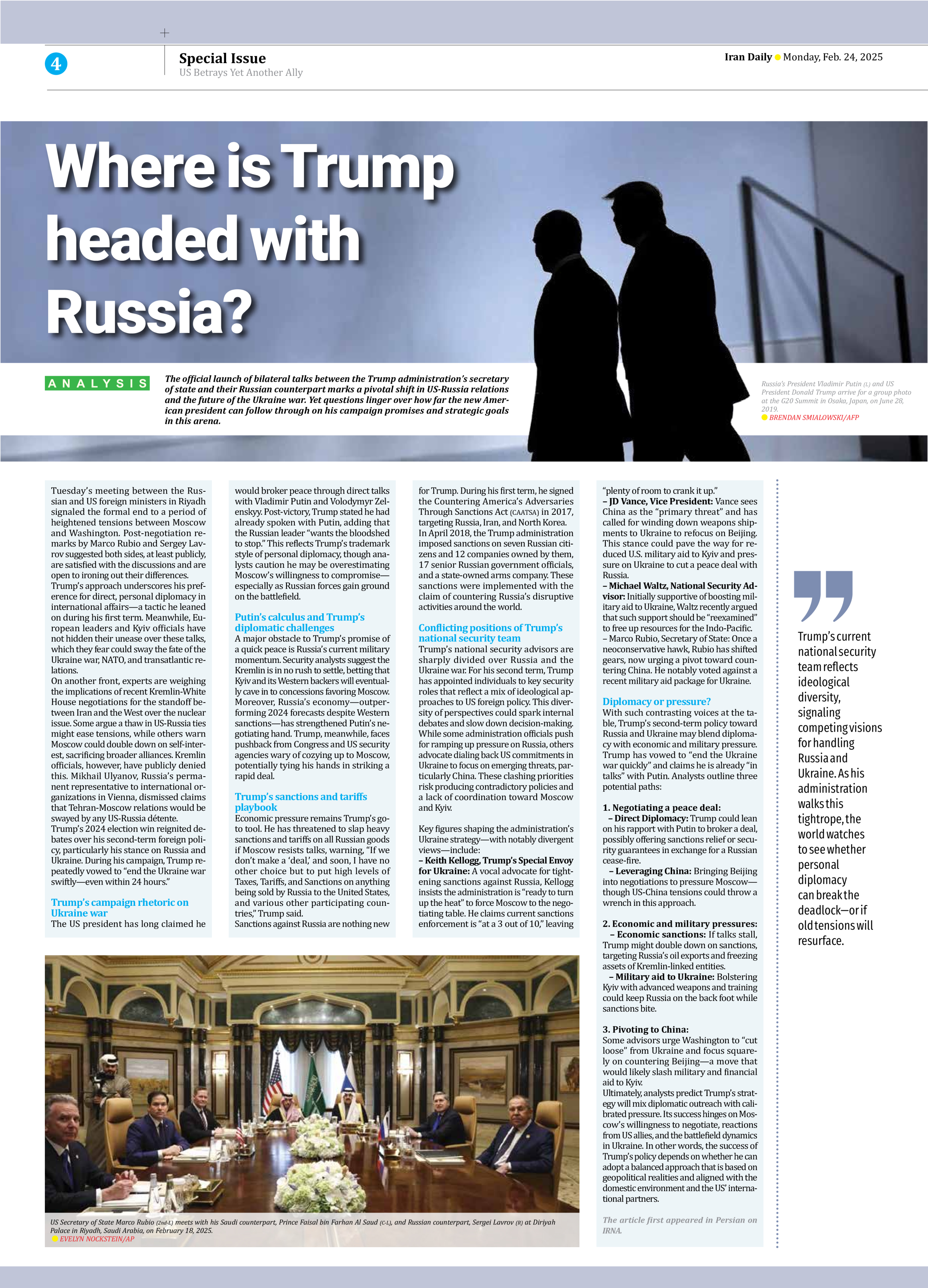
Where is Trump headed with Russia?
The official launch of bilateral talks between the Trump administration’s secretary of state and their Russian counterpart marks a pivotal shift in US-Russia relations and the future of the Ukraine war. Yet questions linger over how far the new American president can follow through on his campaign promises and strategic goals in this arena.
Tuesday’s meeting between the Russian and US foreign ministers in Riyadh signaled the formal end to a period of heightened tensions between Moscow and Washington. Post-negotiation remarks by Marco Rubio and Sergey Lavrov suggested both sides, at least publicly, are satisfied with the discussions and are open to ironing out their differences.
Trump’s approach underscores his preference for direct, personal diplomacy in international affairs—a tactic he leaned on during his first term. Meanwhile, European leaders and Kyiv officials have not hidden their unease over these talks, which they fear could sway the fate of the Ukraine war, NATO, and transatlantic relations.
On another front, experts are weighing the implications of recent Kremlin-White House negotiations for the standoff between Iran and the West over the nuclear issue. Some argue a thaw in US-Russia ties might ease tensions, while others warn Moscow could double down on self-interest, sacrificing broader alliances. Kremlin officials, however, have publicly denied this. Mikhail Ulyanov, Russia’s permanent representative to international organizations in Vienna, dismissed claims that Tehran-Moscow relations would be swayed by any US-Russia détente.
Trump’s 2024 election win reignited debates over his second-term foreign policy, particularly his stance on Russia and Ukraine. During his campaign, Trump repeatedly vowed to “end the Ukraine war swiftly—even within 24 hours.”
Trump’s campaign rhetoric on Ukraine war
The US president has long claimed he would broker peace through direct talks with Vladimir Putin and Volodymyr Zelenskyy. Post-victory, Trump stated he had already spoken with Putin, adding that the Russian leader “wants the bloodshed to stop.” This reflects Trump’s trademark style of personal diplomacy, though analysts caution he may be overestimating Moscow’s willingness to compromise—especially as Russian forces gain ground on the battlefield.
Putin’s calculus and Trump’s diplomatic challenges
A major obstacle to Trump’s promise of a quick peace is Russia’s current military momentum. Security analysts suggest the Kremlin is in no rush to settle, betting that Kyiv and its Western backers will eventually cave in to concessions favoring Moscow.
Moreover, Russia’s economy—outperforming 2024 forecasts despite Western sanctions—has strengthened Putin’s negotiating hand. Trump, meanwhile, faces pushback from Congress and US security agencies wary of cozying up to Moscow, potentially tying his hands in striking a rapid deal.
Trump’s sanctions and tariffs playbook
Economic pressure remains Trump’s go-to tool. He has threatened to slap heavy sanctions and tariffs on all Russian goods if Moscow resists talks, warning, “If we don’t make a ‘deal,’ and soon, I have no other choice but to put high levels of Taxes, Tariffs, and Sanctions on anything being sold by Russia to the United States, and various other participating countries,” Trump said.
Sanctions against Russia are nothing new for Trump. During his first term, he signed the Countering America’s Adversaries Through Sanctions Act (CAATSA) in 2017, targeting Russia, Iran, and North Korea.
In April 2018, the Trump administration imposed sanctions on seven Russian citizens and 12 companies owned by them, 17 senior Russian government officials, and a state-owned arms company. These sanctions were implemented with the claim of countering Russia’s disruptive activities around the world.
Conflicting positions of Trump’s national security team
Trump’s national security advisors are sharply divided over Russia and the Ukraine war. For his second term, Trump has appointed individuals to key security roles that reflect a mix of ideological approaches to US foreign policy. This diversity of perspectives could spark internal debates and slow down decision-making.
While some administration officials push for ramping up pressure on Russia, others advocate dialing back US commitments in Ukraine to focus on emerging threats, particularly China. These clashing priorities risk producing contradictory policies and a lack of coordination toward Moscow and Kyiv.
Key figures shaping the administration’s Ukraine strategy—with notably divergent views—include:
– Keith Kellogg, Trump’s Special Envoy for Ukraine: A vocal advocate for tightening sanctions against Russia, Kellogg insists the administration is “ready to turn up the heat” to force Moscow to the negotiating table. He claims current sanctions enforcement is “at a 3 out of 10,” leaving “plenty of room to crank it up.”
– JD Vance, Vice President: Vance sees China as the “primary threat” and has called for winding down weapons shipments to Ukraine to refocus on Beijing. This stance could pave the way for reduced U.S. military aid to Kyiv and pressure on Ukraine to cut a peace deal with Russia.
– Michael Waltz, National Security Advisor: Initially supportive of boosting military aid to Ukraine, Waltz recently argued that such support should be “reexamined” to free up resources for the Indo-Pacific.
– Marco Rubio, Secretary of State: Once a neoconservative hawk, Rubio has shifted gears, now urging a pivot toward countering China. He notably voted against a recent military aid package for Ukraine.
Diplomacy or pressure?
With such contrasting voices at the table, Trump’s second-term policy toward Russia and Ukraine may blend diplomacy with economic and military pressure. Trump has vowed to “end the Ukraine war quickly” and claims he is already “in talks” with Putin. Analysts outline three potential paths:
1. Negotiating a peace deal:
– Direct Diplomacy: Trump could lean on his rapport with Putin to broker a deal, possibly offering sanctions relief or security guarantees in exchange for a Russian cease-fire.
– Leveraging China: Bringing Beijing into negotiations to pressure Moscow—though US-China tensions could throw a wrench in this approach.
2. Economic and military pressures:
– Economic sanctions: If talks stall, Trump might double down on sanctions, targeting Russia’s oil exports and freezing assets of Kremlin-linked entities.
– Military aid to Ukraine: Bolstering Kyiv with advanced weapons and training could keep Russia on the back foot while sanctions bite.
3. Pivoting to China:
Some advisors urge Washington to “cut loose” from Ukraine and focus squarely on countering Beijing—a move that would likely slash military and financial aid to Kyiv.
Ultimately, analysts predict Trump’s strategy will mix diplomatic outreach with calibrated pressure. Its success hinges on Moscow’s willingness to negotiate, reactions from US allies, and the battlefield dynamics in Ukraine. In other words, the success of Trump’s policy depends on whether he can adopt a balanced approach that is based on geopolitical realities and aligned with the domestic environment and the US’ international partners.
The article first appeared in Persian on IRNA.







